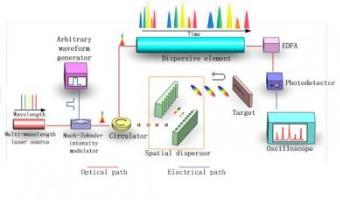Jul 29 2014
Ultrafast real-time optical imaging is an effective and important tool for studying dynamical events, such as shock waves, neural activity, laser surgery and chemical dynamics in living cells. Limited by the frame rate, conventional imaging system such as charge-coupled device (CCD) and complementary metal oxide semiconductor (CMOS) imaging device can not image fast dynamic processes.
 This is the experimental setup of the STEAM system for ultrafast imaging based on a multi-wavelength laser. Credit: ©Science China Press
This is the experimental setup of the STEAM system for ultrafast imaging based on a multi-wavelength laser. Credit: ©Science China Press
Last few years, serial time-encoded amplified microscopy (STEAM) technique based on space-frequency mapping combined with frequency-time mapping has been demonstrated as a completely new optical imaging modality. By employing a spatial disperser and a dispersive element, the spatial information is converted to a serial sequence in time and can be detected with a single-pixel photodiode and captured by a real-time oscilloscope. However, these methods need a large and high-cost pulsed laser; for this type of lasers, the spectral width is generally limited to about 10 nm which limits the measurement range. In addition, the pulse repetition rate is fixed to dozens of megahertz which in turn means that the imaging frame rate is also fixed to dozens of megahertz.
Recently, a new study entitled by "Serial time-encoded amplified microscopy for ultrafast imaging based on multi-wavelength laser" was published in the Chinese Science Bulletin. Professor LI Ming and his group from the Institute of Semiconductors, Chinese Academy of Sciences have figured out a STEAM system by employing a multi-wavelength laser to overcome those limitations. Based on mutually phase-uncorrelated lasing lines, the system avoids the need for a broadband coherent laser light source and the limitations of the measurement range and the imaging frame rate. Compared with a pulsed laser, the use of a multi-wavelength laser as the light source can relieve the cost of the STEAM system. The measurement range can be largely extended by simply increasing the number of wavelength. The frame rate is also reconfigurable by electrically tuning the gating rate. A frame rate up to 250 MHz is experimentally obtained in this work. With the development of photonic integrate circuits (PIC), the multi-wavelength laser source has the potential for integration on a photonic chip and thus the size and cost of the STEAM system could be largely reduced in the future.
Source: http://zh.scichina.com/